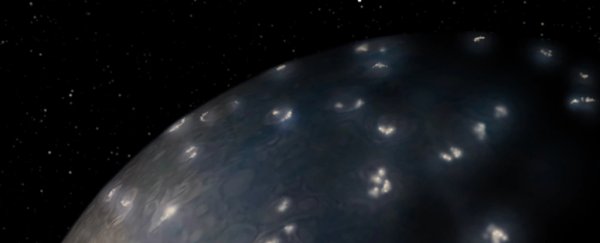Lightning on Jupiter has always been something of a mystery. But thanks to the latest efforts of the Juno probe, we now know that it is actually far more similar to lightning on Earth than we had thought - but it's also still pretty weird, too.
Data from everyone's favourite Jupiter probe has revealed that, contrary to previous measurements, the gas giant's lightning does occur in megahertz frequencies, and occurs much more frequently than thought - but it also seems to be localised to the planet's poles.
The findings are detailed in two new papers.
Jupiter's turbulent atmosphere is riddled with storms, so it stands to reason there's lightning there too. This had long been hypothesised - and when Voyager 1 flew by Jupiter in March 1979, the space probe confirmed it, with follow-up observations made by Voyager 2, Galileo and Cassini.
These low-frequency radio signals detected by Voyager were dubbed "whistlers" because they resembled a descending whistled note.
But there was something weird about them, compared to our Earth lightning.
"No matter what planet you're on, lightning bolts act like radio transmitters - sending out radio waves when they flash across a sky," said Juno scientist Shannon Brown of NASA's Jet Propulsion Laboratory.
"But until Juno, all the lightning signals recorded by spacecraft were limited to either visual detections or from the kilohertz range of the radio spectrum, despite a search for signals in the megahertz range. Many theories were offered up to explain it, but no one theory could ever get traction as the answer."
Now, for the first time, Brown's team has detected atmospheric radio signals from lightning - called sferics - in the megahertz range, and it's thanks to Juno's suite of new and highly sensitive instruments.
In particular, the Microwave Radiometer Instrument, which can detect radio emissions in a wide range of frequencies.
"In the data from our first eight flybys, Juno's MWR detected 377 lightning discharges," Brown said.
"They were recorded in the megahertz as well as gigahertz range, which is what you can find with terrestrial lightning emissions. We think the reason we are the only ones who can see it is because Juno is flying closer to the lighting than ever before, and we are searching at a radio frequency that passes easily through Jupiter's ionosphere."
But the team also noted something not like Earth at all: Jupiter's lightning activity is clustered around its poles. There's none at the equator. On Earth, the opposite is true - and the team believes it has to do with heat.
On Earth, radiation from the Sun provides the most warmth to the planet's equator, which is why the equatorial zone between the tropical latitudes is so warm (and stormy).
On gas giant Jupiter, five times Earth's distance from the Sun, much gentler solar radiation also provides the most warmth to the planet's equator, but it has a different effect. It stabilises the planet's upper atmosphere, preventing warm flows from rising from below.
The poles don't experience this stabilising radiation, so warm gases from the planet's interior can rise to the upper atmosphere. This, the scientists believe, drives atmospheric convection, which in turn creates tremendous storms.
However, lightning appears to be more common in the planet's northern hemisphere, and for that the researchers have yet to find an explanation.
But there's one more way lightning on Jupiter is similar to Earth lightning. In the second paper, scientists from the Czech Academy of Sciences present the largest database of Jovian whistlers yet.
The team recorded over 1,600 of the signals, compared to just 167 collected by Voyager 1. And they detected peak rates of four lightning strikes per second, similar to rates observed in Earth thunderstorms. Voyager detected a peak of just one strike every few seconds.
Together, these findings represent the most detailed and comprehensive look at Jupiter's lightning to date, and provide important clues to figuring out the complex dynamics hidden by the planet's opaque layers of stormy clouds.
"These findings could help to improve our understanding of the composition, circulation and energy flows on Jupiter," said Brown.
The papers have been published in Nature and Nature Astronomy, respectively.
